In an era when climate scientists warn that immediate action is required to control atmospheric carbon dioxide (CO2), biochar—charcoal made by burning waste organic materials like agricultural residues—offers a way to reduce CO2 levels.
 Wheat Crop. Image Credit: Frolova_Elena/Shutterstock
Wheat Crop. Image Credit: Frolova_Elena/Shutterstock
New maps created from a first-of-its-kind high-resolution global collection of crop residues highlight places where the residues can be used to manufacture biochar in a sustainable manner.
According to the study, 12 countries have the technical capability to store more than 20% of their current total greenhouse gas emissions by turning crop leftovers into biochar. Bhutan leads the way, with the ability to store 68% of its emissions as biochar, followed by India (53%).
The study, titled “Potential for Biochar Carbon Sequestration from Crop Residues: A Global Spatially Explicit Assessment,” was published in the journal GCB Bioenergy on October 13th, 2023.
We are entering an unprecedented era in which even a rapid and profound reduction in fossil fuel use will not be enough to avoid severe harms to both humans and ecosystems from climate change.
Dominic Woolf, Study Co-Lead Author and Senior Research Associate, College of Agriculture and Life Sciences, Cornell University
Woolf added, “We also need to draw down excess CO2. Making biochar from crop residues is one of the few tools we have that can do this at scale without competing for land.”
Biochar boosts soil fertility and promotes plant development while simultaneously removing CO2 from the environment. Biochar, when added to soil, sequesters carbon in the soil for centuries.
The study concludes that a maximum of one billion metric tons of carbon might be sequestered annually if all crop leftovers produced by agriculture worldwide were turned into biochar. After a century, three-quarters of that carbon would still be sequestered, which is sufficient to counteract about 80% of all greenhouse gas emissions from agriculture.
“Even when considering limitations on sustainable residue harvesting and competing usage for crop residues—such as livestock feed—the global biochar production potential is approximately half of that amount,” Woolf added.
With these constraints taken into account, the potential annual worldwide production of biochar is estimated to be 510 million metric tons of carbon, of which 360 million metric tons will remain sequestered after a century.
Woolf concluded, “The high-resolution maps of crop residue production and biochar sequestration will provide valuable insights and support decision-making related to biochar production and investment in biochar production capacity.”
The study’s co-lead author is Shivesh Kishore Karan, a researcher at the Swedish University of Agricultural Sciences. Stephen Wood, a senior scientist at the Nature Conservancy, and Elias Azzi and Cecilia Sundberg, both from the Swedish University of Agricultural Sciences, are the co-authors.
The Nature Conservancy and the Bezos Earth Fund supported the study.
Journal Reference:
Karan, S. K., et al. (2023) Potential for biochar carbon sequestration from crop residues: A global spatially explicit assessment. GCB Bioenergy. doi:10.1111/gcbb.13102